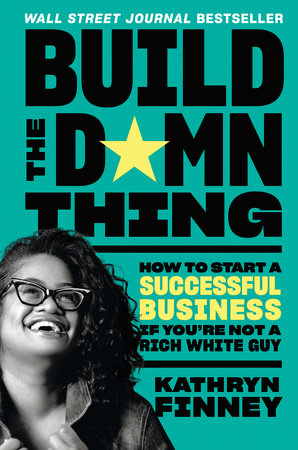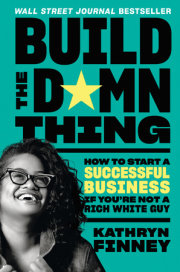Step 1
Get Your Mind Right: How to Build Your Internal Foundation
As a Builder, you are the head of your company. If you're not good, then the company will not be good either. It doesn't matter that you've invented a way to make your cat's litter box smell like cinnamon donuts or that you have so much money that your bank has its own bank. Taking time to mentally prepare yourself for the daunting task of building a company will give you a much bigger return on your investment than just jumping in.
Those of us who are moms have a saying: "If mommy ain't good, then no one is good." Moms are often the people who keep the wheels turning in a family, serving as the comforter and moral center. If the hub-the center of the wheel-is broken, it's impossible for the spokes to turn and propel the family forward. As a mom, your self-care is also your family's self-care.
The same is also true as the CEO of your company. Your self-care is also your company's self-care. You are the hub of your company.
You bring your full life experiences to everything you do, especially building a company. You can't build anything-a company, a family, or even a fence-if you're not in a good place internally. And if you're not in a good place internally, there is no shame in stopping now.
Not everyone can or should be an entrepreneur. You could even say that choosing to be an entrepreneur is an exercise in bad judgment. Most new companies fail. Entrepreneurship is an extremely lonely endeavor, and it involves a great deal of risk, both personal and financial. Not everyone can or should assume this level of risk.
And that is okay.
But if you do want to embark on the quest for a creative life you control through entrepreneurship, preparation is key. Taking time to get yourself in a good place is the single most important thing you can do to ensure the success of your company before you build it.
Building Your Internal Foundation
There's a tendency to define success as something outside ourselves. We say, "If I just get this job/investment/partner, then I will be successful." While these types of achievements can help you along the path to success, they are external. The path to success is internal. As a Builder, there will be times when the only person who can see your vision will be you. You are your own boss, and any boss worth their weight in stock options understands that self-awareness-knowing who you are and acknowledging your strengths and weaknesses-is an extremely important part of being a great leader.
In order to build your company, you will need to get comfortable with uncertainty, risk, and failure. You must be able to manage the stress and challenges that come from the realities of building a startup. Of the hundreds of companies I've encountered throughout the years, the ones that succeeded were the ones whose founders built a strong internal foundation before executing their ideas.
Smart, successful entrepreneurs have no problem spending time on their mental and spiritual health. My dear friend Kendra Bracken-Ferguson, co-founder of the health company r¥spin with Oscar winner Halle Berry, has a formal yoga practice that she does every day. I'm a member of a group of exceptional women entrepreneurs and leaders called TheLi.st. During the COVID-19 pandemic, the CEO of the group gave its members a free month of a meditation app. Getting your mind right is crucial to getting your company right.
Builder Trap: Fear of Failure
I've missed more than nine thousand shots in my career. I've lost almost three hundred games. Twenty-six times I've been trusted to take the game-winning shot and missed. I've failed over and over and over again in my life. And that is why I succeed.
Michael Jordan
As you set out to build your company, know that failure is part of the journey. Failing isn't fun, and most people quit when things don't immediately start working out.
But not you . . .
It can be even harder when you're a Builder because some people expect you to fail. There's a big difference between having permission to fail and the expectation that you will fail. Permission means that failure is part of the journey, not the end result. Expectation assumes that the journey, no matter what you do, will end in failure. It assumes the path you take is rigged and so full of sinkholes, land mines, and bear traps that no matter how carefully you walk it, you'll lose your way.
However . . .
I know from personal experience that you can turn the expectation of failure on its head to become wildly successful. I watched my father do exactly that. The key is to give yourself permission to have a big vision of who you want to become and not let expectations (whether internal or external) influence your ability to make that vision a reality.
The Power of Fearlessness: Defying Expectations
Long before the TV show Happy Days, serial killers, and dudes with bedazzled pianos, Milwaukee, Wisconsin, was a beer factory town of proud, hardworking German, Polish, and African American citizens living in the shadow of its bigger sister to the south, Chicago.
It's in this environment that my grandmother Anna Mae gave birth to my father, Robert "Bob" Finney. While my grandmother's family wasn't impoverished-they owned a house in 1940, a pretty amazing feat for people of any race-my grandmother was very rebellious and became pregnant with my father at age sixteen. Consequently, my father was raised by her parents, my great-grandparents, Walter and Lucille. In fact, he didn't know my grandmother was his mom until he was in his early teens.
Now imagine having your life turned upside down at a time when you have hormones raging through your body. The people you thought were your parents aren't really your parents. The person you thought was your sister is really your mom. This culture of silence to protect "respectability" was prevalent throughout American society in both Black and white communities, and more common than most of us would think.
However, my dad was a young Black man in mid-twentieth-century America who wasn't given permission to mourn and struggle with life-changing information. There was no child psychologist available in his blue-collar, working-class community. A straight-A student at a racially mixed high school, he wanted to be a surgeon. When he told his white high school guidance counselor, the counselor instead explained to a young Bob Finney that his goal was beyond his reach. He should focus on learning a trade and working in the brewery.
My dad, like most young Black men in 1960s America, was expected to fail.
So my dad, too, started to rebel. He stole a car and found himself on the wrong side of the law. The judge who decided his fate gave him a choice: go to jail or go to war. This was in 1964, right in the escalation of the Vietnam War. My father, who had only ever been as far as Chicago, enlisted in the army at sixteen years old. Imagine being a teenager leaving everything and everyone you've known to travel to literally the other side of the world. Imagine the fear of the unknown, of war, of the very real possibility of never coming back home.
After serving two tours in Vietnam he returned to Milwaukee and did what every good Milwaukeean did: went to work at one of the city's many breweries (in his case, Schlitz). Working at the brewery was a great job-you could make $50,000 a year in the 1970s without a high school diploma. However, spurred on by my well-educated mom, my dad went back to school while working the third shift. He got his GED, graduating with a 3.9 GPA, and then an associate's degree, all while supporting two children and working a full-time job.
In this time of Zoom work and Microsoft Teams, where meeting your coworkers in person feels rare, it can be hard to understand that working at a factory or brewery was more than a job, it was a community. My parents socialized with their coworkers after work. My brother and I were in Little League and Girl Scouts with their children. Schlitz would often have these elaborate Christmas parties in one of the shipping hangars, with a Santa, gifts, and lots of food.
So you can imagine the devastation when the brewery shut down.
The shutdown was quick; the brewery was open on a Tuesday and gone on Wednesday. It devastated Milwaukee. It devastated my family.
After the brewery closed down, my dad took whatever jobs he could to support the family, including driving a Little Debbie Snack Cake truck. He eventually found his way to a place called the Opportunities Industrialization Center (OIC), a network of workforce development centers founded in 1964 to train (and retrain) workers in impoverished communities. The OIC was located a few blocks away from the now-closed brewery. At the OIC, my dad took a Saturday basic C++ class taught by a computer programmer from IBM named Monroe Shaw.
I give you all this backstory because it's super important to understand the path my father had to walk in order to go from a displaced brewery worker with an associate's degree from Milwaukee Area Technical College and a job driving a food-service truck in 1983 to a senior engineer at Microsoft in 1993.
In 1980s America, there was nothing to indicate that a displaced Black factory worker with a GED could be anything more than a displaced Black factory worker with a GED. There was no Google to read about others who had turned failure into success and no Instagram to scroll through quotes from successful people displayed on floral backgrounds. There were no Jay-Zs or Nipsey Hussles, who went from gangs to superrich businessmen. There were no Oprahs or Rihannas, who rose from abusive childhoods to become billionaires.
No. There was absolutely, positively NO indication that my dad would become a millionaire by age fifty.
Except for one thing.
My father took a risk. He took a shot with the military, with his GED. He also took a shot when he met an ambitious young woman (my mom) who was definitely out of his league (and a big thanks for that for obvious reasons).
What is equally notable was that my mom gave my father, at great risk to herself, permission to take shots. She gave him permission to fail. In December 1982, the month that Schlitz shut down, the Wisconsin unemployment rate was 11.5 percent. My mother saw that the possibility of a career in a growing industry and better schools for her children far outweighed the alternative of staying where she loved, near people who loved her, but in a city that was dying.
In the '80s, the average Joe (or Bob) had no idea of the possibilities of computing. The internet wasn't a thing, having a computer in your home was super new, and there were definitely no personal cell phones. I'm 99 percent sure my dad had other things he would have preferred to do with his Saturdays (like sleep), but he took a shot at the OIC class.
The class turned into an unpaid internship at IBM. The internship led to a job offer as an entry-level programmer at Digital Equipment Corporation (DEC), the Boston-based early pioneer in computing, in Minneapolis, Minnesota.
Geographically, Minneapolis isn't that far from Milwaukee, just a five-hour drive (three hundred miles) up I-94. But culturally, it was the other side of the moon. It was different in little ways, like how everyone's last name ended with "son" (Olson, Anderson, Nelson . . .). And in big ways: it was colder, richer, and whiter. We had a strong support system in Milwaukee; both of my grandmothers lived there, along with a large extended family. To move away from everything we knew to another city was the biggest shot my father had ever taken in his life.
The expectation was not only that my dad would fail, but by default my entire family would fail. "Friends" told my mom that putting her career on hold was "stupid" and that my father would leave her. Some told my parents that their kids would come back "white."
Yet for my parents, the opportunity to create a stable, creative life that they controlled was more powerful than any naysayers. So my parents, my brother, and I packed up the Chevy Cavalier and headed to the home of Prince and lutefisk, Minneapolis.
My dad rose through the ranks at DEC and was recruited as a senior software engineer at Microsoft. He was an executive at EMC, an early data storage company, when he passed away in 2002.
The universe was conspiring for my father's greatness.
Failure Is Part of the Journey
My father's story is not unique. The path to success isn't a straight line. All successful people have stories of deep challenges. Everyone who has ever succeeded has failed, had to pivot, or taken a huge risk-sometimes all three at the same time.
As Builders, we don't get to own our success because when we fail, it doesn't just impact us, it impacts entire communities. It impacts the family members who gave us money they really didn't have to lose because they so believed in our vision. Those who put their hopes and dreams on our success become tied to our failure as well. The pressure to succeed without ever experiencing a single setback is real. But it isn't realistic.
For so long the ability to take risks-and building a company is risky-was something that only Entitleds could do. If you know that the median net worth of a Black family is $24,000, close to one eighth of that of a white family, then you are uniquely aware of the economic impact of your mom taking a second mortgage to fund your business. If you watched your parents work at backbreaking jobs that didn't match their skill levels, just so you would have an opportunity for success, you want to show them that the sacrifice was worth it. If you're the friend and family whom everyone turns to for economic support, you know the impact of rededicating your resources away from them to build an idea.
Failure isn't an option when you're a Builder. Except that every successful person has failed. The trick is knowing how to fail before you hit rock bottom. The old saying that "the definition of insanity is repeating the same mistake over and over again and expecting different results" is especially true when building a company. It's hard to correct your course if you have no idea you're heading in the wrong direction. Failure shows you that you are on the wrong course and it's time for a change. Learning what doesn't work is as important as learning what does work, and that means becoming comfortable with failure and learning to overcome it.
Copyright © 2022 by Kathryn Finney. All rights reserved. No part of this excerpt may be reproduced or reprinted without permission in writing from the publisher.











